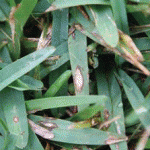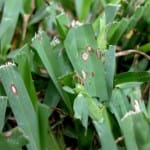Source(s): Alfredo Martinez-Espinoza
Susceptible Turfgrass
St. Augustine grass is most commonly attacked by gray leaf spot but it also attacks perennial ryegrass, Bermuda grass, centipede grass, bent grass and various species of fescue. Gray leaf spot is especially severe on new St. Augustine lawns.
Symptoms
The symptoms of gray leaf spot vary depending on the grass cultivar. On St. Augustine grass, gray leaf spot first appears as small, brown spots on the leaves and stems. The spots quickly enlarge to approximately ¼ inch in length and become bluish-gray in color and oval or elongated in shape. Mature lesions are tan to gray in color and have depressed centers with irregular margins that are purple to brown in color. A yellow border on the lesions can also occur. In cool-season turf grass, the symptoms are similar to those of melting-out.
Conditions Favoring Disease
Gray leaf spot is favored by daytime temperatures between 80ºF to 90ºF and night temperatures above 65ºF. It is also found in areas with high nitrogen levels and that are stressed by various factors, including drought and soil compaction. This disease is most severe during extended hot, rainy and humid periods.
Management of Gray Leaf Spot
- Avoid medium to high nitrogen levels during mid-summer. Use fertilizers with slow-release nitrogen sources.
- Irrigate turf deeply and as infrequently as possible to avoid water stress.
- Allow water to remain on leaves for only a short period of time. Water from 10 pm to 10 am.
- Reduce thatch by vertical cutting.
- When possible, plant turf grass that is resistant to gray leaf spot.
- Avoid using herbicides or plant growth regulators when the disease is active.
- Fungicides are available to control the disease. Consult the current Georgia Pest Management Handbook.
Resource(s):
- Turfgrass Diseases in Georgia
- Guide to Turfgrass Fungicides
- Turfgrass Diseases: Quick Reference Guide
- Brown Patch and Pythium Blight - July 22, 2018
- Gray Leaf Spot - July 22, 2018
- Gray Leaf Spot in Turf - September 24, 2013

